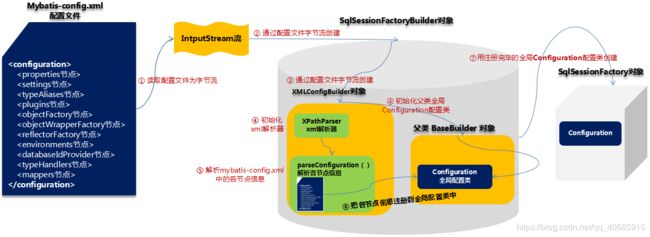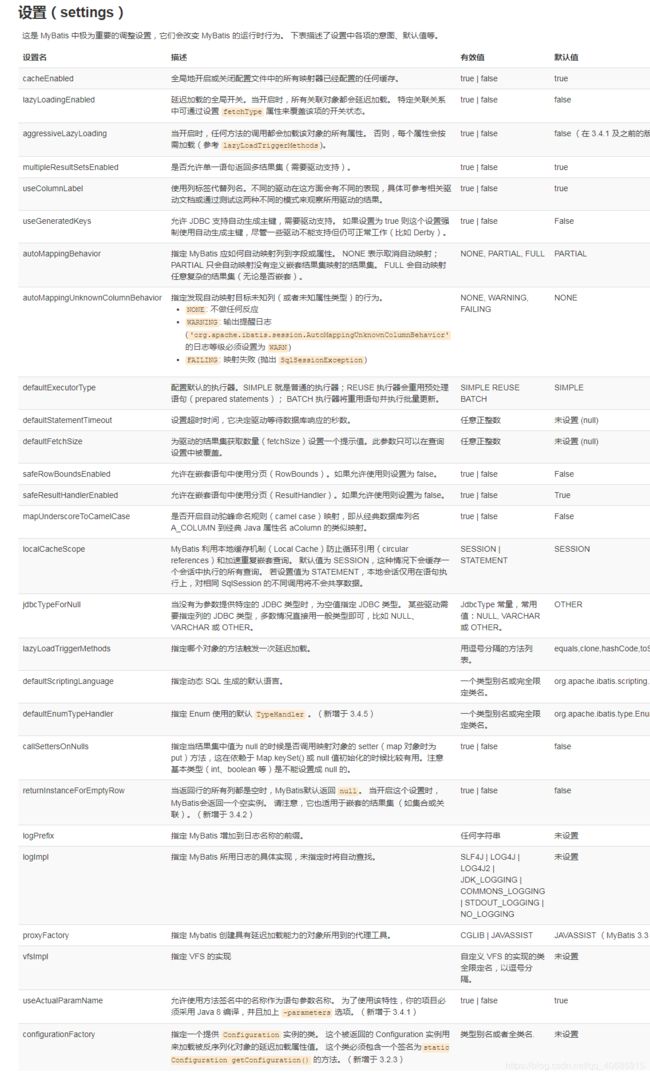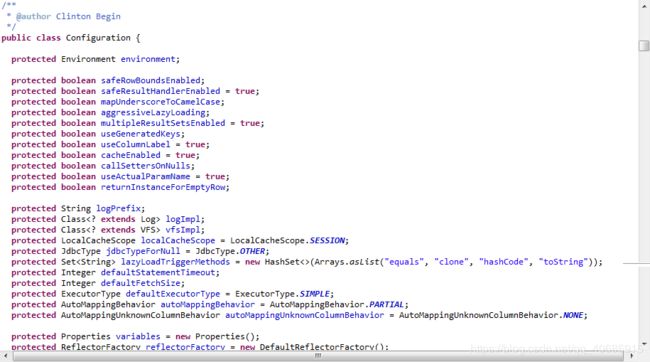Mybatis源码分析(4)---配置节点settings源码解析
- 背景
在上篇Mybatis源码分析(3)—配置节点properties源码解析中,我们通过解析properties节点在于XMLConfigBuilder类中的propertiesElement(XNode context)方法源码,了解了整个properties节点的解析过程。
今天接下来我们将对节点settings进行源码分析,分析之前,依然先通过以下图来重温一下之前SqlSessionFactory对象创建的过程:

当然,我们依然围绕着Demo工程mybatisCode对节点settings进行深入的解析和测试 - 节点settings介绍
这里我们就不进行过多的介绍,在Mybatis官网中,对settings节点的描述为:MyBatis 中极为重要的调整设置,它们会改变 MyBatis 的运行时行为。配置完整的 settings 元素内容有以下:
<settings>
<setting name="cacheEnabled" value="true"/>
<setting name="lazyLoadingEnabled" value="true"/>
<setting name="multipleResultSetsEnabled" value="true"/>
<setting name="useColumnLabel" value="true"/>
<setting name="useGeneratedKeys" value="false"/>
<setting name="autoMappingBehavior" value="PARTIAL"/>
<setting name="autoMappingUnknownColumnBehavior" value="WARNING"/>
<setting name="defaultExecutorType" value="SIMPLE"/>
<setting name="defaultStatementTimeout" value="25"/>
<setting name="defaultFetchSize" value="100"/>
<setting name="safeRowBoundsEnabled" value="false"/>
<setting name="mapUnderscoreToCamelCase" value="false"/>
<setting name="localCacheScope" value="SESSION"/>
<setting name="jdbcTypeForNull" value="OTHER"/>
<setting name="lazyLoadTriggerMethods" value="equals,clone,hashCode,toString"/>
</settings>
每个setting元素设置的详细描述,大家可以去官网中mybatis - Mybatis3 | 配置 设置(settings)直接学习了解:

3. 节点settings源码
- 首先我们先来看看节点settings源码的位置:XMLConfigBuilder类中的parseConfiguration(XNode root)方法中
private void parseConfiguration(XNode root) {
try {
propertiesElement(root.evalNode("properties"));
//解析节点
Properties settings = settingsAsProperties(root.evalNode("settings"));
//解析后settings配置作为参数传入loadCustomVfs方法
loadCustomVfs(settings);
//解析后settings配置作为参数传入loadCustomLogImpl方法
loadCustomLogImpl(settings);
typeAliasesElement(root.evalNode("typeAliases"));
pluginElement(root.evalNode("plugins"));
objectFactoryElement(root.evalNode("objectFactory"));
objectWrapperFactoryElement(root.evalNode("objectWrapperFactory"));
reflectorFactoryElement(root.evalNode("reflectorFactory"));
//解析后settings配置作为参数传入settingsElement方法
settingsElement(settings);
environmentsElement(root.evalNode("environments"));
databaseIdProviderElement(root.evalNode("databaseIdProvider"));
typeHandlerElement(root.evalNode("typeHandlers"));
mapperElement(root.evalNode("mappers"));
} catch (Exception e) {
throw new BuilderException("Error parsing SQL Mapper Configuration. Cause: " + e, e);
}
}
通过上面源码我们,大概了解了settings节点的解析过程:先加载整个settings的元素到集合Properties中,然后再把带着Properties集合传递到具体的方法中,进行具体的处理,那整个源码具体详细的解析过程是什么样子的呢?
接下来我们将按照上面settings解析过程,深入到源码方法中去窥探。
- Properties settingsAsProperties(XNode context)源码解析
根据方法名和返回参数,我们能知道mybatis把settings节点元素加载了Properties集合配置类中:
private Properties settingsAsProperties(XNode context) {
//如果mybatis-config.xml没有配置节点,则返回一个空的Properties配置类集合
if (context == null) {
return new Properties();
}
//getChildrenAsProperties方法在XNode类中,下面的XNode类中该方法的源码,我们可以了解一下
// 把节点中的所有元素的name和value属性值已K-V形式设置到Properties配置类中
Properties props = context.getChildrenAsProperties();
// Check that all settings are known to the configuration class
// 直接翻译上面源码的因为注释:检查全局配置类Configuration是否知道所有settings设置
// MetaClass类中作用就是把Configuration的所有属性的命名封装为起来
// 然后对元素中的name进行遍历判断是否非Configuration全局配置类中的属性名称,存在非法的属性名称进行异常抛出
MetaClass metaConfig = MetaClass.forClass(Configuration.class, localReflectorFactory);
//遍历所有元素解析后name属性值,既Properties props中的Key
for (Object key : props.keySet()) {
//判断key是否存在,不存在则抛出BuilderException异常
//这里提醒一下大家,如果你启动mybatis出现下面的异常msg,可以直接就定位到settings节点中某个元素setting的name属性值配置错误了
if (!metaConfig.hasSetter(String.valueOf(key))) {
throw new BuilderException("The setting " + key + " is not known. Make sure you spelled it correctly (case sensitive).");
}
}
return props;
}
XNode类中getChildrenAsProperties() 方法源码
public Properties getChildrenAsProperties() {
Properties properties = new Properties();
//遍历节点的元素
for (XNode child : getChildren()) {
//获取元素的name属性的字符串值
String name = child.getStringAttribute("name");
//获取元素的value属性的字符串值
String value = child.getStringAttribute("value");
if (name != null && value != null) {
//name属性值作为key,value属性值作为value,存放到Properties集合中
properties.setProperty(name, value);
}
}
return properties;
}
Configuration类中的属性名称,与上面官网截图的设置名一一对应,以后我们有机会将单独对Configuration类进行源码分析介绍

- loadCustomVfs(settings)方法源码分析----指定VFS 的实现
VFS :虚拟文件系统,主要是通过程序能够方便读取本地文件系统、FTP文件系统等系统中的文件资源,通过该配置可以加载自定义的虚拟文件系统应用程序,具体了解VFS可以通过文章《什么是vfs以及vfs的作用》阅读
private void loadCustomVfs(Properties props) throws ClassNotFoundException {
//获取元素中name属性为vfsImpl的value值
String value = props.getProperty("vfsImpl");
if (value != null) {
//自定义VFS的实现的类全限定名,以逗号分隔
String[] clazzes = value.split(",");
for (String clazz : clazzes) {
if (!clazz.isEmpty()) {
//利用反射获取VFS实现类的Class对象
@SuppressWarnings("unchecked")
Class<? extends VFS> vfsImpl = (Class<? extends VFS>)Resources.classForName(clazz);
//最后注册到全局配置类Configuration中的vfsImpl容器中
configuration.setVfsImpl(vfsImpl);
}
}
}
}
- loadCustomLogImpl(settings)方法源码分析
指定 MyBatis 所用日志的具体实现,未指定时将自动查找
指定的类型有:SLF4J | LOG4J | LOG4J2 | JDK_LOGGING | COMMONS_LOGGING | STDOUT_LOGGING | NO_LOGGING
private void loadCustomLogImpl(Properties props) {
Class<? extends Log> logImpl = resolveClass(props.getProperty("logImpl"));
//最后注册到全局配置类Configuration中的logImpl容器中
configuration.setLogImpl(logImpl);
}
- settingsElement(settings)源码分析
调用该方法之后,mybatis会把settings节点的所有设置挨个的注册到全局配置类Configuration中的各个属性容器,此时settings节点的解析基本结束,把各个seting元素的中的设置的东西别注册到了Configuration中
private void settingsElement(Properties props) {
configuration.setAutoMappingBehavior(AutoMappingBehavior.valueOf(props.getProperty("autoMappingBehavior", "PARTIAL")));
configuration.setAutoMappingUnknownColumnBehavior(AutoMappingUnknownColumnBehavior.valueOf(props.getProperty("autoMappingUnknownColumnBehavior", "NONE")));
configuration.setCacheEnabled(booleanValueOf(props.getProperty("cacheEnabled"), true));
configuration.setProxyFactory((ProxyFactory) createInstance(props.getProperty("proxyFactory")));
configuration.setLazyLoadingEnabled(booleanValueOf(props.getProperty("lazyLoadingEnabled"), false));
configuration.setAggressiveLazyLoading(booleanValueOf(props.getProperty("aggressiveLazyLoading"), false));
configuration.setMultipleResultSetsEnabled(booleanValueOf(props.getProperty("multipleResultSetsEnabled"), true));
configuration.setUseColumnLabel(booleanValueOf(props.getProperty("useColumnLabel"), true));
configuration.setUseGeneratedKeys(booleanValueOf(props.getProperty("useGeneratedKeys"), false));
configuration.setDefaultExecutorType(ExecutorType.valueOf(props.getProperty("defaultExecutorType", "SIMPLE")));
configuration.setDefaultStatementTimeout(integerValueOf(props.getProperty("defaultStatementTimeout"), null));
configuration.setDefaultFetchSize(integerValueOf(props.getProperty("defaultFetchSize"), null));
configuration.setMapUnderscoreToCamelCase(booleanValueOf(props.getProperty("mapUnderscoreToCamelCase"), false));
configuration.setSafeRowBoundsEnabled(booleanValueOf(props.getProperty("safeRowBoundsEnabled"), false));
configuration.setLocalCacheScope(LocalCacheScope.valueOf(props.getProperty("localCacheScope", "SESSION")));
configuration.setJdbcTypeForNull(JdbcType.valueOf(props.getProperty("jdbcTypeForNull", "OTHER")));
configuration.setLazyLoadTriggerMethods(stringSetValueOf(props.getProperty("lazyLoadTriggerMethods"), "equals,clone,hashCode,toString"));
configuration.setSafeResultHandlerEnabled(booleanValueOf(props.getProperty("safeResultHandlerEnabled"), true));
configuration.setDefaultScriptingLanguage(resolveClass(props.getProperty("defaultScriptingLanguage")));
configuration.setDefaultEnumTypeHandler(resolveClass(props.getProperty("defaultEnumTypeHandler")));
configuration.setCallSettersOnNulls(booleanValueOf(props.getProperty("callSettersOnNulls"), false));
configuration.setUseActualParamName(booleanValueOf(props.getProperty("useActualParamName"), true));
configuration.setReturnInstanceForEmptyRow(booleanValueOf(props.getProperty("returnInstanceForEmptyRow"), false));
configuration.setLogPrefix(props.getProperty("logPrefix"));
configuration.setConfigurationFactory(resolveClass(props.getProperty("configurationFactory")));
}
- 结尾
以上就是整个mybatis-config.xml中节点settings在mybatis初始化过程中解析的过程。
通过此篇文章,我们进一步的了解到全局配置类Configuration的强大,可以说它是mybatis的核心,整个mybatis的运行所需要的东西均来源它,而它的组成来源于各个节点的解析。
对于节点settings设置的解析,有很多元素非常有用,具体大家可以根据官网提供的setting元素需要进行测试